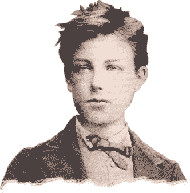|
A black, E white, I
red, U green, O
blue: vowels,
I shall tell, one day, of your mysterious origins:
A, black velvety jacket of brilliant flies
which buzz around cruel smells,
Gulfs of shadow; E,
whiteness of vapours and of tents,
lances of proud glaciers, white kings, shivers
of cow-parsley;
I, purples, spat
blood, smile of beautiful lips
in anger or in the raptures of penitence;
U, waves, divine
shudderings of viridian seas,
the peace of pastures dotted with animals, the
peace of the furrows
which alchemy prints on broad studious foreheads;
O, sublime Trumpet
full of strange piercing sounds,
silences crossed by [Worlds and by Angels]:
–O the Omega!
the violet ray of [His] Eyes!
|

